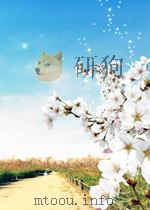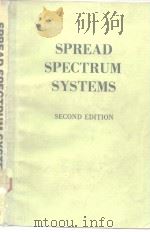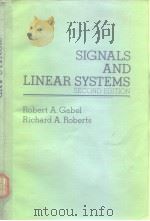《SIGNALS & SYSTEMS SECOND EDITION》
| 作者 | 编者 |
|---|---|
| 出版 | 未查询到或未知 |
| 参考页数 | 957 |
| 出版时间 | 1997(求助前请核对) 目录预览 |
| ISBN号 | 0138147574 — 求助条款 |
| PDF编号 | 812192148(仅供预览,未存储实际文件) |
| 求助格式 | 扫描PDF(若分多册发行,每次仅能受理1册) |

1 SIGNALS AND SYSTEMS1
1.0 Introduction1
1.1 Continuous-Time and Discrete-Time Signals1
1.1.1 Examples and Mathematical Representation1
1.1.2 Signal Energy and Power5
1.2 Transformations of the Independent Variable7
1.2.1 Examples of Transformations of the Independent Variable8
1.2.2 Periodic Signals11
1.2.3 Even and Odd Signals13
1.3 Exponential and Sinusoidal Signals14
1.3.1 Continuous-Time Complex Exponential and Sinusoidal Signals15
1.3.2 Discrete-Time Complex Exponential and Sinusoidal Signals21
1.3.3 Periodicity Properties of Discrete-Time Complex Exponentials25
1.4 The Unit Impulse and Unit Step Functions30
1.4.1 The Discrete-Time Unit Impulse and Unit Step Sequences30
1.4.2 The Continuous-Time Unit Step and Unit Impulse Functions32
1.5 Continuous-Time and Discrete-Time Systems38
1.5.1 Simple Examples of Systems39
1.5.2 Interconnections of Systems41
1.6 Basic System Properties44
1.6.1 Systems with and without Memory44
1.6.2 Invertibility and Inverse Systems45
1.6.3 Causality46
1.6.4 Stability48
1.6.5 Time Invariance50
1.6.6 Linearity53
1.7 Summary56
Problems57
2 LINEAR TIME-INVARIANT SYSTEMS74
2.0 Introduction74
2.1 Discrete-Time LTI Systems: The Convolution Sum75
2.1.1 The Representation of Discrete-Time Signals in Terms of Impulses75
2.1.2 The Discrete-Time Unit Impulse Response and the Convolution-Sum Representation of LTI Systems77
2.2 Continuous-Time LTI Systems: The Convolution Integral90
2.2.1 The Representation of Continuous-Time Signals in Terms of Impulses90
2.2.2 The Continuous-Time Unit Impulse Response and the Convolution Integral Representation of LTI Systems94
2.3 Properties of Linear Time-Invariant Systems103
2.3.1 The Commutative Property104
2.3.2 The Distributive Property104
2.3.3 The Associative Property107
2.3.4 LTI Systems with and without Memory108
2.3.5 Invertibility of LTI Systems109
2.3.6 Causality for LTI Systems112
2.3.7 Stability for LTI Systems113
2.3.8 The Unit Step Response of an LTI System115
2.4 Causal LTI Systems Described by Differential and Difference Equations116
2.4.1 Linear Constant-Coefficient Differential Equations117
2.4.2 Linear Constant-Coefficient Difference Equations121
2.4.3 Block Diagram Representations of First-Order Systems Described by Differential and Difference Equations124
2.5 Singularity Functions127
2.5.1 The Unit Impulse as an Idealized Short Pulse128
2.5.2 Defining the Unit Impulse through Convolution131
2.5.3 Unit Doublets and Other Singularity Functions132
2.6 Summary137
Problems137
3 FOURIER SERIES REPRESENTATION OF PERIODIC SIGNALS177
3.0 Introduction177
3.1 A Historical Perspective178
3.2 The Response of LTI Systems to Complex Exponentials182
3.3 Fourier Series Representation of Continuous-Time Periodic Signals186
3.3.1 Linear Combinations of Harmonically Related Complex Exponentials186
3.3.2 Determination of the Fourier Series Representation of a Continuous-Time Periodic Signal190
3.4 Convergence of the Fourier Series195
3.5 Properties of Continuous-Time Fourier Series202
3.5.1 Linearity202
3.5.2 Time Shifting202
3.5.3 Time Reversal203
3.5.4 Time Scaling204
3.5.5 Multiplication204
3.5.6 Conjugation and Conjugate Symmetry204
3.5.7 Parseval's Relation for Continuous-Time Periodic Signals205
3.5.8 Summary of Properties of the Continuous-Time Fourier Series205
3.5.9 Examples205
3.6 Fourier Series Representation of Discrete-Time Periodic Signals211
3.6.1 Linear Combinations of Harmonically Related Complex Exponentials211
3.6.2 Determination of the Fourier Series Representation of a Periodic Signal212
3.7 Properties of Discrete-Time Fourier Series221
3.7.1 Multiplication222
3.7.2 First Difference222
3.7.3 Parseval's Relation for Discrete-Time Periodic Signals223
3.7.4 Examples223
3.8 Fourier Series and LTI Systems226
3.9 Filtering231
3.9.1 Frequency-Shaping Filters232
3.9.2 Frequency-Selective Filters236
3.10 Examples of Continuous-Time Filters Described by Differential Equations239
3.10.1 A Simple RC Lowpass Filter239
3.10.2 A Simple RC Highpass Filter241
3.11 Examples of Discrete-Time Filters Described by Difference Equations244
3.11.1 First-Order Recursive Discrete-Time Filters244
3.11.2 Nonrecursive Discrete-Time Filters245
3.12 Summary249
Problems250
4 THE CONTINUOUS-TIME FOURIER TRANSFORM284
4.0 Introduction284
4.1 Representation of Aperiodic Signals: The Continuous-Time Fourier Transform285
4.1.1 Development of the Fourier Transform Representation of an Aperiodic Signal285
4.1.2 Convergence of Fourier Transforms289
4.1.3 Examples of Continuous-Time Fourier Transforms290
4.2 The Fourier Transform for Periodic Signals296
4.3 Properties of the Continuous-Time Fourier Transform300
4.3.1 Linearity301
4.3.2 Time Shifting301
4.3.3 Conjugation and Conjugate Symmetry303
4.3.4 Differentiation and Integration306
4.3.5 Time and Frequency Scaling308
4.3.6 Duality309
4.3.7 Parseval's Relation312
4.4 The Convolution Property314
4.4.1 Examples317
4.5 The Multiplication Property322
4.5.1 Frequency-Selective Filtering with Variable Center Frequency325
4.6 Tables of Fourier Properties and of Basic Fourier Transform Pairs328
4.7 Systems Characterized by Linear Constant-Coefficient Differential Equations330
4.8 Summary333
Problems334
5 THE DISCRETE-TIME FOURIER TRANSFORM358
5.0 Introduction358
5.1 Representation of Aperiodic Signals: The Discrete-Time Fourier Transform359
5.1.1 Development of the Discrete-Time Fourier Transform359
5.1.2 Examples of Discrete-Time Fourier Transforms362
5.1.3 Convergence Issues Associated with the Discrete-Time Fourier Transform366
5.2 The Fourier Transform for Periodic Signals367
5.3 Properties of the Discrete-Time Fourier Transform372
5.3.1 Periodicity of the Discrete-Time Fourier Transform373
5.3.2 Linearity of the Fourier Transform373
5.3.3 Time Shifting and Frequency Shifting373
5.3.4 Conjugation and Conjugate Symmetry375
5.3.5 Differencing and Accumulation375
5.3.6 Time Reversal376
5.3.7 Time Expansion377
5.3.8 Differentiation in Frequency380
5.3.9 Parseval's Relation380
5.4 The Convolution Property382
5.4.1 Examples383
5.5 The Multiplication Property388
5.6 Tables of Fourier Transform Properties and Basic Fourier Transform Pairs390
5.7 Duality390
5.7.1 Duality in the Discrete-Time Fourier Series391
5.7.2 Duality between the Discrete-Time Fourier Transform and the Continuous-Time Fourier Series395
5.8 Systems Characterized by Linear Constant-Coefficient Difference Equations396
5.9 Summary399
Problems400
6 TIME AND FREQUENCY CHARACTERIZATION OF SIGNALS AND SYSTEMS423
6.0 Introduction423
6.1 The Magnitude-Phase Representation of the Fourier Transform423
6.2 The Magnitude-Phase Representation of the Frequency Response of LTI Systems427
6.2.1 Linear and Nonlinear Phase428
6.2.2 Group Delay430
6.2.3 Log-Magnitude and Bode Plots436
6.3 Time-Domain Properties of Ideal Frequency-Selective Filters439
6.4 Time-Domain and Frequency-Domain Aspects of Nonideal Filters444
6.5 First-Order and Second-Order Continuous-Time Systems448
6.5.1 First-Order Continuous-Time Systems448
6.5.2 Second-Order Continuous-Time Systems451
6.5.3 Bode Plots for Rational Frequency Responses456
6.6 First-Order and Second-Order Discrete-Time Systems461
6.6.1 First-Order Discrete-Time Systems461
6.6.2 Second-Order Discrete-Time Systems465
6.7 Examples of Time- and Frequency-Domain Analysis of Systems472
6.7.1 Analysis of an Automobile Suspension System473
6.7.2 Examples of Discrete-Time Nonrecursive Filters476
6.8 Summary482
Problems483
7 SAMPLING514
7.0 Introduction514
7.1 Representation of a Continuous-Time Signal by Its Samples: The Sampling Theorem515
7.1.1 Impulse-Train Sampling516
7.1.2 Sampling with a Zero-Order Hold520
7.2 Reconstruction of a Signal from Its Samples Using Interpolation522
7.3 The Effect of Undersampling: Aliasing527
7.4 Discrete-Time Processing of Continuous-Time Signals534
7.4.1 Digital Differentiator541
7.4.2 Half-Sample Delay543
7.5 Sampling of Discrete-Time Signals545
7.5.1 Impulse-Train Sampling545
7.5.2 Discrete-Time Decimation and Interpolation549
7.6 Summary555
Problems556
8 COMMUNICATION SYSTEMS582
8.0 Introduction582
8.1 Complex Exponential and Sinusoidal Amplitude Modulation583
8.1.1 Amplitude Modulation with a Complex Exponential Carrier583
8.1.2 Amplitude Modulation with a Sinusoidal Carrier585
8.2 Demodulation for Sinusoidal AM587
8.2.1 Synchronous Demodulation587
8.2.2 Asynchronous Demodulation590
8.3 Frequency-Division Multiplexing594
8.4 Single-Sideband Sinusoidal Amplitude Modulation597
8.5 Amplitude Modulation with a Pulse-Train Carrier601
8.5.1 Modulation of a Pulse-Train Carrier601
8.5.2 Time-Division Multiplexing604
8.6 Pulse-Amplitude Modulation604
8.6.1 Pulse-Amplitude Modulated Signals604
8.6.2 Intersymbol Interference in PAM Systems607
8.6.3 Digital Pulse-Amplitude and Pulse-Code Modulation610
8.7 Sinusoidal Frequency Modulation611
8.7.1 Narrowband Frequency Modulation613
8.7.2 Wideband Frequency Modulation615
8.7.3 Periodic Square-Wave Modulating Signal617
8.8 Discrete-Time Modulation619
8.8.1 Discrete-Time Sinusoidal Amplitude Modulation619
8.8.2 Discrete-Time Transmodulation623
8.9 Summary623
Problems625
9 THE LAPLACE TRANSFORM654
9.0 Introduction654
9.1 The Laplace Transform655
9.2 The Region of Convergence for Laplace Transforms662
9.3 The Inverse Laplace Transform670
9.4 Geometric Evaluation of the Fourier Transform from the Pole-Zero Plot674
9.4.1 First-Order Systems676
9.4.2 Second-Order Systems677
9.4.3 All-Pass Systems681
9.5 Properties of the Laplace Transform682
9.5.1 Linearity of the Laplace Transform683
9.5.2 Time Shifting684
9.5.3 Shifting in the 5-Domain685
9.5.4 Time Scaling685
9.5.5 Conjugation687
9.5.6 Convolution Property687
9.5.7 Differentiation in the Time Domain688
9.5.8 Differentiation in the s-Domain688
9.5.9 Integration in the Time Domain690
9.5.10 The Initial-and Final-Value Theorems690
9.5.11 Table of Properties691
9.6 Some Laplace Transform Pairs692
9.7 Analysis and Characterization of LTI Systems Using the Laplace Transform693
9.7.1 Causality693
9.7.2 Stability695
9.7.3 LTI Systems Characterized by Linear Constant-Coefficient Differential Equations698
9.7.4 Examples Relating System Behavior to the System Function701
9.7.5 Butterworth Filters703
9.8 System Function Algebra and Block Diagram Representations706
9.8.1 System Functions for Interconnections of LTI Systems707
9.8.2 Block Diagram Representations for Causal LTI Systems Described by Differential Equations and Rational System Functions708
9.9 The Unilateral Laplace Transform714
9.9.1 Examples of Unilateral Laplace Transforms714
9.9.2 Properties of the Unilateral Laplace Transform716
9.9.3 Solving Differential Equations Using the Unilateral Laplace Transform719
9.10 Summary720
Problems721
10 THE Z-TRANSFORM741
10.0 Introduction741
10.1 The z-Transform741
10.2 The Region of Convergence for the z-Transform748
10.3 The Inverse z-Transform757
10.4 Geometric Evaluation of the Fourier Transform from the Pole-Zero Plot763
10.4.1 First-Order Systems763
10.4.2 Second-Order Systems765
10.5 Properties of the z-Transform767
10.5.1 Linearity767
10.5.2 Time Shifting767
10.5.3 Scaling in the z-Domain768
10.5.4 Time Reversal769
10.5.5 Time Expansion769
10.5.6 Conjugation770
10.5.7 The Convolution Property770
10.5.8 Differentiation in the z-Domain772
10.5.9 The Initial-Value Theorem773
10.5.10 Summary of Properties774
10.6 Some Common z-Transform Pairs774
10.7 Analysis and Characterization of LTI Systems Using z-Transforms774
10.7.1 Causality776
10.7.2 Stability777
10.7.3 LTI Systems Characterized by Linear Constant-Coefficient Difference Equations779
10.7.4 Examples Relating System Behavior to the System Function781
10.8 System Function Algebra and Block Diagram Representations783
10.8.1 System Functions for Interconnections of LTI Systems784
10.8.2 Block Diagram Representations for Causal LTI Systems Described by Difference Equations and Rational System Functions784
10.9 The Unilateral z-Transform789
10.9.1 Examples of Unilateral z-Transforms and Inverse Transforms790
10.9.2 Properties of the Unilateral z-Transform792
10.9.3 Solving Difference Equations Using the Unilateral z-Transform795
10.10 Summary796
Problems797
11 LINEAR FEEDBACK SYSTEMS816
11.0 Introduction816
11.1 Linear Feedback Systems819
11.2 Some Applications and Consequences of Feedback820
11.2.1 Inverse System Design820
11.2.2 Compensation for Nonideal Elements821
11.2.3 Stabilization of Unstable Systems823
11.2.4 Sampled-Data Feedback Systems826
11.2.5 Tracking Systems828
11.2.6 Destabilization Caused by Feedback830
11.3 Root-Locus Analysis of Linear Feedback Systems832
11.3.1 An Introductory Example833
11.3.2 Equation for the Closed-Loop Poles834
11.3.3 The End Points of the Root Locus: The Closed-Loop Poles for K = 0 and |K| = +∞836
11.3.4 The Angle Criterion836
11.3.5 Properties of the Root Locus841
11.4 The Nyquist Stability Criterion846
11.4.1 The Encirclement Property847
11.4.2 The Nyquist Criterion for Continuous-Time LTI Feedback Systems850
11.4.3 The Nyquist Criterion for Discrete-Time LTI Feedback Systems856
11.5 Gain and Phase Margins858
11.6 Summary866
Problems867
APPENDIX PARTIAL-FRACTION EXPANSION909
BIBLIOGRAPHY921
ANSWERS931
INDEX941
1997《SIGNALS & SYSTEMS SECOND EDITION》由于是年代较久的资料都绝版了,几乎不可能购买到实物。如果大家为了学习确实需要,可向博主求助其电子版PDF文件。对合法合规的求助,我会当即受理并将下载地址发送给你。
高度相关资料
-
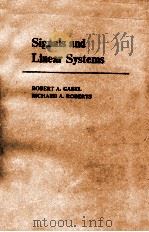
- SIGNALS AND LINEAR SYSTEMS
- 1973 JOHN WILEY & SONS
-
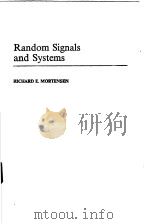
- RANDOM SIGNALS AND SYSTEMS
- JOHN WILEY & SONS
-
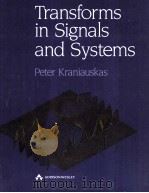
- Transforms in Signals and Systems
- 1992 Addison-Wesley Publishing Ltd
-
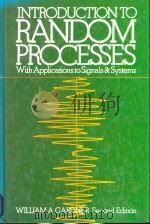
- Introduction to random processes with applications to signals and systems Second Edition
- 1990 McGraw-Hill
-

- MANAGEMENT INFORMATION SYSTEMS SECOND EDITION
- 1992 MCGRAW-HILL
-
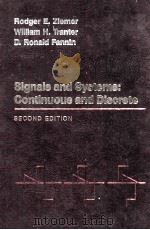
- SIGNALS AND SYSTEMS:CONTINUOUS AND DISCRETE SECOND EDITION
- 1989 MACMILLAN PUBLISHING COMPANY
-
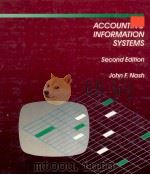
- ACCOUNTING INFORMATION SYSTEMS SECOND EDITION
- 1989 PWS-KENT PUBLISHING COMPANY
-

- Signals and systems : continuous and discrete third edition
- 1993 Maxwell Macmillan International
-
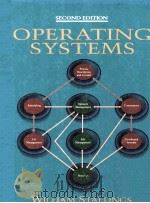
- OPERATING SYSTEMS SECOND EDITION
- 1995 PRENTICE HALL
-

- AUDITING EDP SYSTEMS SECOND EDITION
- 1990 PRENTICE HALL
提示:百度云已更名为百度网盘(百度盘),天翼云盘、微盘下载地址……暂未提供。➥ PDF文字可复制化或转WORD

